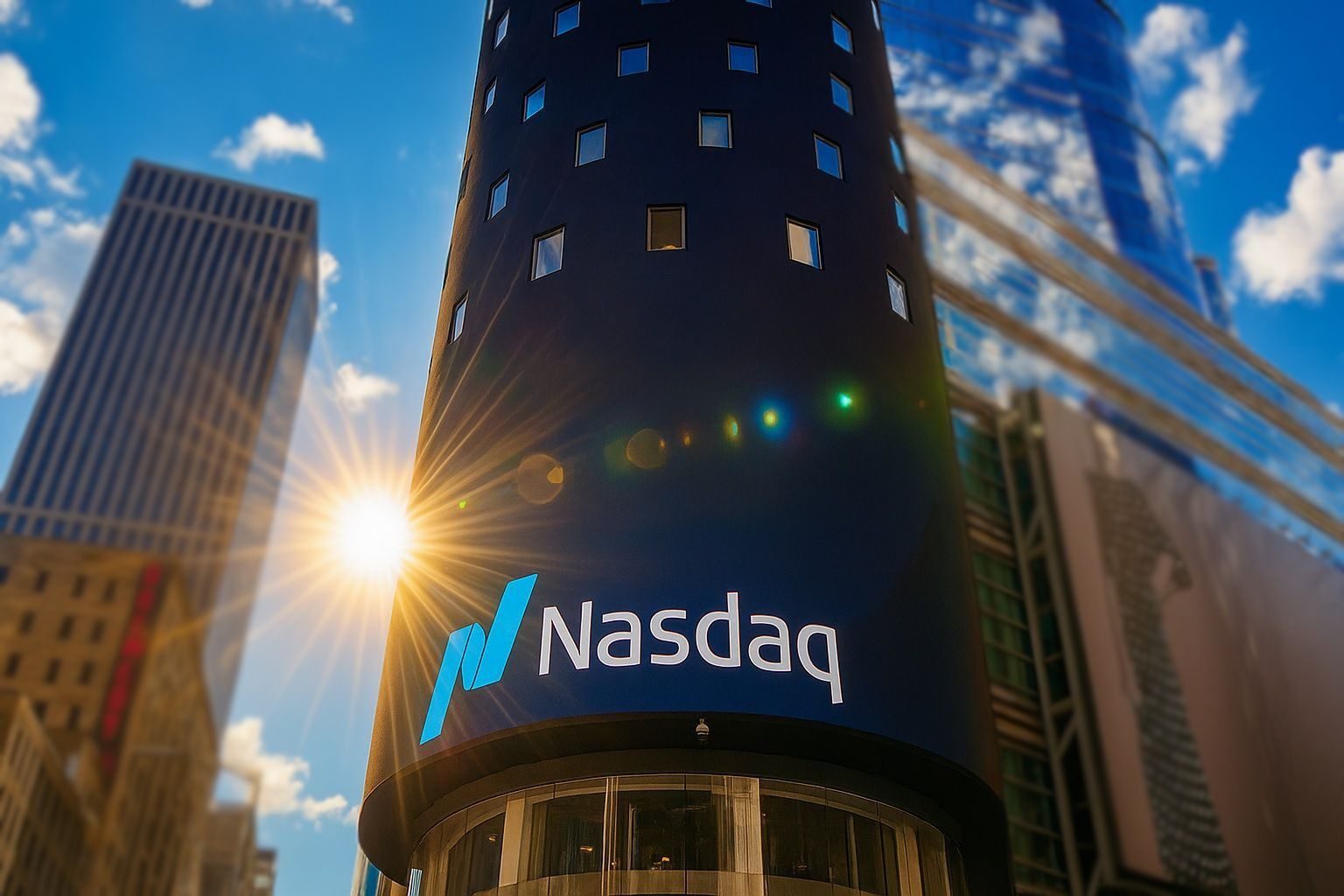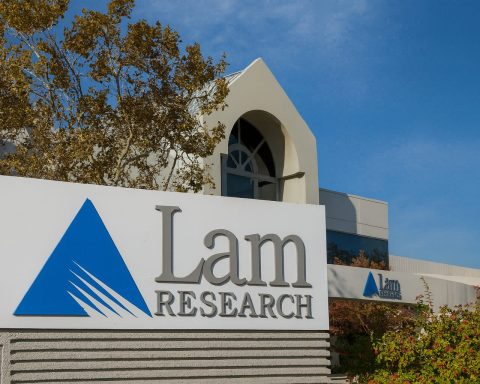The Nasdaq Composite pushed higher again on Tuesday, extending its rebound even as key chip stocks stumbled under fresh AI competition headlines.
As the closing bell rang on Wall Street at 4 p.m. ET, the Nasdaq Composite finished at 23,025.59, up 153.59 points (+0.67%), notching its third straight advance. The S&P 500 rose 0.91% to 6,765.88, while the Dow Jones Industrial Average jumped 1.43% to 47,112.45. The small‑cap Russell 2000 outperformed with a 2.1% surge to 2,465.98. [1]
Tuesday’s gains build on Monday’s powerful tech-led rally, when the Nasdaq vaulted 2.7% to 22,872.01, its biggest one-day percentage jump in roughly six months. [2]
Rate-cut optimism keeps the Nasdaq’s rally alive
The overarching story for the Nasdaq today wasn’t a single stock; it was interest rates.
A batch of U.S. data released Tuesday painted a picture of slowing but not collapsing economic momentum:
- September retail sales rose 0.2% month-on-month, weaker than the 0.4% economists expected. [3]
- Producer prices (PPI) increased 2.7% year-on-year, a touch hotter than forecasts, but the core PPI measure was slightly cooler than expected at 2.6%. [4]
- Consumer confidence tumbled more than forecast in November, reflecting growing anxiety ahead of the holiday season. [5]
Taken together, the data nudged investors further toward the view that the Federal Reserve is likely to deliver a third rate cut at its December 9–10 meeting. Fed funds futures now imply roughly an 80–85% probability of a 25-basis-point cut, up dramatically from about a coin-flip a week ago. [6]
Bond markets leaned the same way. The 10‑year Treasury yield slipped to around 4.00% from 4.04% on Monday, easing financial conditions and providing classic tailwind for growth and tech names. [7]
For a rate‑sensitive, growth‑heavy index like the Nasdaq, that’s essentially someone loosening the gravity settings.
AI chip drama: Alphabet rises while Nvidia and AMD sag
If rates were the macro engine, AI chips were the main plot twist.
A report from The Information said Meta Platforms is in talks to spend “billions” on Google’s tensor processing unit (TPU) AI chips, potentially renting chips from Google Cloud as soon as next year and deploying them in Meta’s data centers from 2027. [8]
That single story split Big Tech and semis into winners and losers:
- Alphabet (Google’s parent)
- Shares gained roughly 1.3–1.5% by the close, extending an already powerful AI-fueled run and keeping the company on the path toward a $4 trillion market valuation highlighted earlier in the day by Reuters. [9]
- Nvidia (NVDA)
- The AI chip leader fell around 2.6% on the session, having traded down as much as nearly 4% intraday. Investors fretted that a future Meta–Google deal could divert a meaningful slice of AI hardware demand away from Nvidia. [10]
- Advanced Micro Devices (AMD)
- AMD slid about 4.1%, caught in the downdraft across the semiconductor complex. [11]
Nasdaq’s own mid‑session commentary noted that the Nasdaq 100 was down while the Dow and S&P 500 were up earlier in the day, as the chip slump weighed on the tech‑heavy benchmarks. Those losses narrowed into the close as broader rate‑cut optimism broadened the rally beyond chips. [12]
The result: the Nasdaq did advance, but lagged the Dow and small caps, showing how much influence a handful of mega‑cap semis still wield over the index.
Alphabet’s march toward $4 trillion underpins Big Tech sentiment
One reason the Nasdaq stayed green despite Nvidia’s wobble: Alphabet is becoming its own gravitational field.
- A separate Reuters piece earlier in the day flagged that Alphabet was on track to hit a $4 trillion market value, fueled by a year‑long rally tied to its AI strategy and products like the Gemini model. [13]
- Alphabet’s pre‑market gain was more than 4%, and although those early gains cooled, the stock still finished higher on the day and remained one of the most important positive contributors to the Nasdaq. [14]
In other words, the AI trade is no longer a simple “Nvidia = AI” story. Investors are increasingly treating the entire stack—cloud platforms, custom accelerators, software, and data centers—as a competitive battlefield. That shift is starting to show up in intraday divergence between the Nasdaq’s biggest names.
Retailers and small caps steal some of tech’s spotlight
While the Nasdaq is synonymous with tech, some of Tuesday’s loudest moves came from retailers and smaller companies, which benefit the most when investors believe rates are coming down.
From the AP recap and related coverage:
- Kohl’s rocketed roughly 42.5% after swinging to a profit where analysts had expected a loss. [15]
- Abercrombie & Fitch surged about 37.5% on earnings and guidance that topped expectations. [16]
- Best Buy climbed around 5.3% after raising its full‑year profit outlook on strong demand for computing, gaming, and mobile tech. [17]
These moves helped consumer discretionary stocks become one of the best‑performing sectors of the day.
The Russell 2000 small‑cap index’s 2.1% rally underscored how rate‑cut hopes disproportionately boost smaller, more leveraged companies that rely heavily on borrowing costs. [18]
For the Nasdaq, that matters because many of its second‑tier growth names and smaller tech firms are in exactly that bucket: they’re not yet mega‑cap cash machines, and they live or die by the price of money.
Sector snapshot: Health care and consumer names lead, defensives lag
Looking across the market’s sector map:
- Eight of the S&P 500’s 11 sectors closed higher, according to post‑market summaries. [19]
- Health care and consumer discretionary led the charge, each rising roughly 2%, reflecting a mix of earnings strength and rate sensitivity. [20]
- More defensive groups such as energy and utilities finished slightly lower, reflecting a rotation toward risk rather than away from it. [21]
For Nasdaq watchers, that’s a subtle but important point: Tuesday’s move wasn’t purely a speculative tech blow‑off, it was a relatively broad “risk‑on” day, with cyclicals and small caps joining the party.
Macro backdrop: Slower consumer, cooler inflation, and a Fed in the spotlight
From a macro perspective, Tuesday’s Nasdaq story sits at the intersection of three forces:
- Softening consumer data
- Retail sales and consumer confidence both came in weaker than expected, which is not exactly bullish for future earnings—but it is helpful for the argument that the Fed needs to support growth. [22]
- Inflation that’s cooling… but not dead
- Headline producer prices were slightly hotter than forecast, while core inflation was a touch cooler. It’s the kind of mixed bag that lets the Fed say, “We can cut, but we’re not out of the inflation woods yet.” [23]
- Fed credibility and market psychology
- Recent comments from Fed officials such as John Williams and Christopher Waller have been interpreted as relatively dovish, and futures now imply this December cut could be the third and likely final one of the year. [24]
Put simply: the Nasdaq is rallying not because everything is perfect, but because things are “just weak enough” to keep rate cuts on the table without screaming recession.
What today’s move means for Nasdaq investors
A few takeaways for anyone tracking or trading the Nasdaq right now:
- Rate expectations are driving the bus.
The market is treating the December Fed meeting as pivotal. If the Fed hints at fewer cuts than markets are now pricing in, high‑growth areas of the Nasdaq could be vulnerable. - AI is no longer a one‑ticker story.
The Meta–Google chip news shows how quickly leadership can flip even within the AI trade: Alphabet rallies on potential TPU demand while Nvidia and AMD slump on competitive fears. The Nasdaq’s future path will depend not just on whether AI wins, but on which companies capture the economics. [25] - Breadth is improving—but still fragile.
Strong gains in small caps and retail names suggest the rally is widening beyond the usual mega‑cap suspects. But the fact that a single negative headline on Nvidia can still cap the Nasdaq’s upside is a reminder that concentration risk is alive and well. - Short term, the trend is up.
Across the last three sessions, the Nasdaq has climbed more than 3%, clawing back a chunk of November’s earlier losses and moving closer to its record territory. [26]
From here, the next big inflection points for the index will likely be additional inflation readings, consumer data heading into the holidays, and any new twists in the AI‑chip arms race.
References
1. www.wsj.com, 2. www.marketwatch.com, 3. www.nasdaq.com, 4. www.nasdaq.com, 5. www.reuters.com, 6. www.reuters.com, 7. www.latimes.com, 8. www.nasdaq.com, 9. www.reuters.com, 10. www.latimes.com, 11. www.latimes.com, 12. www.nasdaq.com, 13. www.reuters.com, 14. www.reuters.com, 15. www.latimes.com, 16. www.latimes.com, 17. www.latimes.com, 18. apnews.com, 19. english.news.cn, 20. english.news.cn, 21. english.news.cn, 22. www.wdrb.com, 23. www.nasdaq.com, 24. www.reuters.com, 25. nypost.com, 26. www.marketwatch.com







